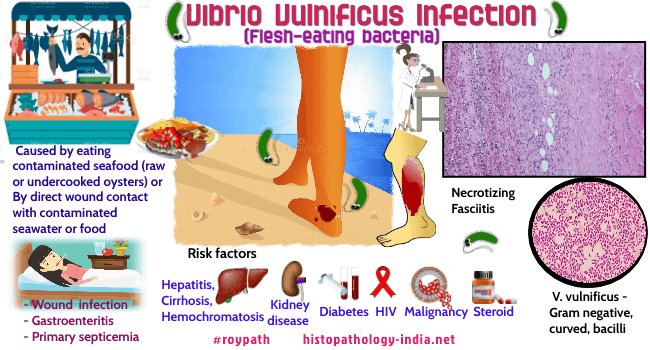|

Custom Search
|
Infectious Disease OnlinePathology Of Vibrio Vulnificus Infection
|
|

Custom Search
|
Infectious Disease OnlinePathology Of Vibrio Vulnificus Infection
|

|
Vulnificus comes from the Latin word for "wounding" - an appropriate name, as this species of Vibrio may cause extensive soft tissue damage. Vibrio vulnificus is also known as "flesh eating bacteria." Vibrio vulnificus, a lactose-positive, gram-negative halophilic marine bacillus, is found in shallow coastal waters, sediment, plankton, and shellfish such as oysters, clams, and crabs. The organism is isolated in high concentrations from shellfish (especially oysters), and during the summer months. In some epidemiologic studies, greater than 50% of shellfish and 11% of crabs harbour the organism during warmer months. This virulent, gram-negative bacterium causes two distinct syndromes. The first is an overwhelming primary septicemia caused by consuming raw or undercooked seafood, particularly raw oysters. The second is a necrotizing wound infection acquired when an open wound is exposed to warm seawater with high concentrations of Vibrio vulnificus. In some countries it is the leading cause of shellfish related deaths. It is a rare cause of necrotizing fasciitis. For the past 20 years, the number of reports on V.vulnificus necrotizing skin and soft tissue infections has risen. Many scientists believe that higher sea surface temperature promote the spread of V. vulnificus in coastal waters and thus contribute to this trend. With global warming, this public health issue will become even more important and urgent. 95% of the reported episodes of Vibrio vulnificus necrotizing skin and soft tissue infections occurred in the subtropical western Pacific and Atlantic coastal regions of the northern hemisphere, such as Taiwan, South Korea, Japan,or the Gulf of Mexico of the United States. Patient presents with sudden onset of shock with high fever resulting in sepsis, decreased clotting, and hepatorenal symptoms, followed by death within a few days. Mortality was up 50% in septic patients, with most of them dying within 48 hrs. Infection with V. vulnificus is associated with predisposing conditions such as hepatitis, cirrhosis, diabetes, hemochromatosis, and immune compromise. High iron load in the bloodstream, as evidenced by elevated levels of ferritin and transferrin saturation in the blood, seems to increase the virulence of the bacillus. Other risk factors for infection are use of steroids and chronic renal failure. The definitive diagnosis of infection by V.vulnificus occurs through the growth of microorganism cultures. Laboratory diagnosis of Vibrio vulnificus infection can be performed by using stool, blood, or lesion cultures. Besides the skin lesions that occur in sepsis, the epidermis may be affected by direct infection through skin lesions that look like bullous cellulitis. At first, there is pain and swelling in the affected limb, followed by rash, and then the emergence of bullous lesions with sero-hemorrhagic fluids, progressing to necrotizing fasciitis. Visit: Necrotizing Fasciitis (Flesh Eating Disease);
|
| Source:
|
|
|
Copyright © 2022 histopathology-india.net